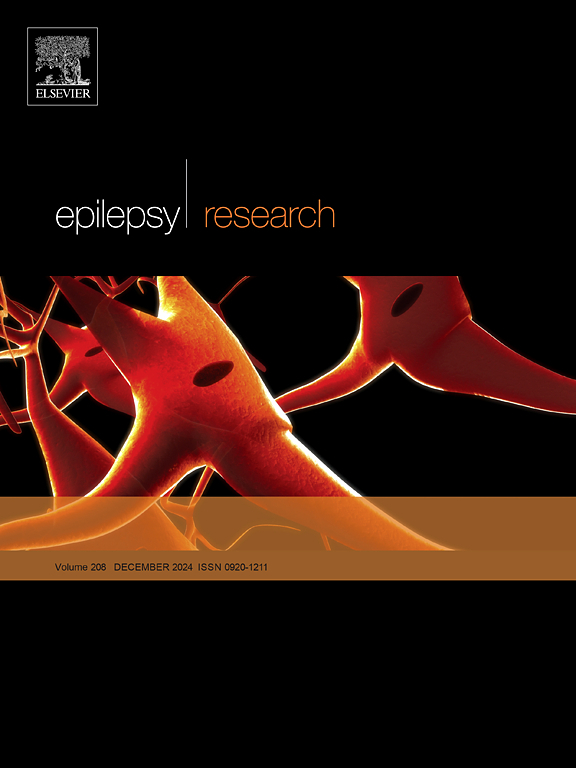Novel insights regarding haemodynamics in focal seizures
IF 2
4区 医学
Q3 CLINICAL NEUROLOGY
引用次数: 0
Abstract
Introduction
We explored the temporal patterns of haemodynamic parameters in four seizures of three patients using the log-ratio method.
Methods
We identified three subjects who experienced a seizure during a tilt table test: one had two focal impaired awareness seizures (FIAS, seizures#1 and#2), one had one FIAS (#3), and one had a focal to bilateral tonic-clonic seizure (fbTCS, seizure#4). Recordings included video, heart rate (HR) and continuous blood pressure (BP). We used the log-ratio method to determine the relative contributions of HR, stroke volume (SV), and total peripheral resistance (TPR) to mean arterial pressure (MAP). A 'phase' was defined as a temporary departure of MAP, HR, SV or TPR from baseline.
Results
BP showed a decrease in all four seizures. We observed one phase with synchronous events for all haemodynamic variables during seizures 1&2; seizure#3 showed one phase for MAP and TPR, three phases for HR, and only one for SV. Seizure#4 showed no autonomic involvement during the first minute of the focal seizure, after which MAP and HR showed an asynchronous triphasic course until the signal was lost when a tonic-clonic seizure occurred.
Conclusion
This chance sample illustrates that haemodynamic variables may change in different directions and asynchronously during focal seizures. We speculate that these complex autonomic patterns represent different ictal propagation pathways and that they may include ictal as well as corrective changes. BP decreased in all four seizures while the literature reports BP increases. As our patients were upright, not supine, we hypothesise that ictal haemodynamic changes impair normal control and are therefore likely to cause hypotension in the upright position.
关于局灶性癫痫的血流动力学的新见解
本文采用对数比法对3例癫痫患者的血流动力学参数进行了时间模式分析。方法:我们确定了3例在倾斜台试验中经历癫痫发作的受试者:1例有两次局灶性意识受损癫痫发作(FIAS,癫痫发作#1和#2),1例有一次FIAS(#3), 1例有局灶性双侧强直-阵挛性癫痫发作(fbTCS,癫痫发作#4)。记录包括视频、心率(HR)和持续血压(BP)。我们使用对数比方法来确定HR、卒中容积(SV)和总外周阻力(TPR)对平均动脉压(MAP)的相对贡献。一个“阶段”被定义为MAP、HR、SV或TPR暂时偏离基线。结果四次发作血压均下降。我们观察到癫痫发作期间所有血流动力学变量都有一个同步事件1&2;癫痫发作#3显示1期MAP和TPR, 3期HR, 1期SV。第4次发作在局灶性发作的第一分钟没有自主神经受累,之后MAP和HR显示一个非同步的三相过程,直到强直阵挛发作时信号消失。结论本病例提示局灶性癫痫发作时血流动力学变量可能发生不同方向的非同步变化。我们推测,这些复杂的自主模式代表了不同的临界点传播途径,它们可能包括临界点和纠正性变化。在所有四次发作中血压都下降,而文献报道血压升高。由于我们的患者是直立的,而不是仰卧的,我们假设临界血流动力学的改变损害了正常的控制,因此可能导致直立体位的低血压。
本文章由计算机程序翻译,如有差异,请以英文原文为准。
求助全文
约1分钟内获得全文
求助全文
来源期刊

Epilepsy Research
医学-临床神经学
CiteScore
0.10
自引率
4.50%
发文量
143
审稿时长
62 days
期刊介绍:
Epilepsy Research provides for publication of high quality articles in both basic and clinical epilepsy research, with a special emphasis on translational research that ultimately relates to epilepsy as a human condition. The journal is intended to provide a forum for reporting the best and most rigorous epilepsy research from all disciplines ranging from biophysics and molecular biology to epidemiological and psychosocial research. As such the journal will publish original papers relevant to epilepsy from any scientific discipline and also studies of a multidisciplinary nature. Clinical and experimental research papers adopting fresh conceptual approaches to the study of epilepsy and its treatment are encouraged. The overriding criteria for publication are novelty, significant clinical or experimental relevance, and interest to a multidisciplinary audience in the broad arena of epilepsy. Review articles focused on any topic of epilepsy research will also be considered, but only if they present an exceptionally clear synthesis of current knowledge and future directions of a research area, based on a critical assessment of the available data or on hypotheses that are likely to stimulate more critical thinking and further advances in an area of epilepsy research.
 求助内容:
求助内容: 应助结果提醒方式:
应助结果提醒方式:


